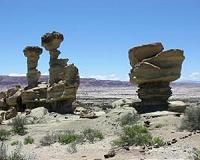 |
Bayreuth, Germany (SPX) Jan 17, 2011 "Don't be a frog!" people say in jest when someone hesitates instead of acting straight away. However to be called a frog should actually be a reason to strengthen one's self-confidence. After all frogs are real winners - at least from the point of view of evolutionary biology: Nearly 6.000 species are known today. "In terms of numbers frogs are superior to all the other amphibians, and even mammals", says Professor Dr. Lennart Olsson from the Friedrich Schiller University Jena (Germany). Professor Olsson's research group for Systematic Zoology examines these animals's special secret of success. "We are interested in how the frogs developed in such a great variety and which evolutionary new development is responsible for making frogs so particularly successful", Jennifer Schmidt from Olsson's team explains. Their evolutionary success is literally written all over the frogs' faces: Certain forms of cartilage and bone structures in the region of the head of the tadpoles are among the frogs' "innovations". These structures only to be found in frogs appear in the oral region. They enable the tadpoles - of the South African claw frog (Xenopus laevis) - particularly well to chip vegetarian food from the soil and from stones or to filter it from the water. In their latest study which has been published in the science magazine "Journal of Anatomy" together with colleagues from Ulm Jennifer Schmidt analysed the central factor for the development of these morphologically distinctive features of the tadpoles. It is well known from earlier analyses, that the gene "FOXN3" plays a key role in the embryonal development of the heads of claw frogs. "It is responsible for the normal development of cartilages, bones and muscles", Jennifer Schmidt explains. In the newly published study the 25 year old doctoral candidate and scholar of the Konrad-Adenauer-Stiftung analysed larvae of the claw frog after the "FOXN3"-gene had been cut off. Then she compared them with untreated larvae. "Our analyses with microCT show that the larvae without an intact 'FOXN3'-gene are developing normally up to a certain time." But then the development slows down, says Jennifer Schmidt. "On the whole these animals grow more slowly." Most of all the cartilages, the bones and muscles don't develop properly. Deformations and loss of functions occur. However not all cartilages and muscles are affected by the cut-off gene. "We were able to show that the 'FOXN3' most of all influences the development of the cartilages in the oral region and the gills", Professor Olsson points out. These structures in particular belong to the evolutionary new developments typical of frogs, which are missing in other amphibians. Jennifer Schmidt would like to continue her analyses in her thesis. "We are going to compare the embryonal development of the claw frogs with those of other amphibians", the zoologist says. It would be interesting to find out to what extent the genetic control of those new developments changed in the course of the evolution.
Share This Article With Planet Earth
Related Links Informationsdienst Wissenschaft Darwin Today At TerraDaily.com
 New Predator 'Dawn Runner' Discovered In Early Dinosaur Graveyard
New Predator 'Dawn Runner' Discovered In Early Dinosaur GraveyardChicago IL (SPX) Jan 17, 2011 A team of paleontologists and geologists from Argentina and the United States have announced the discovery of a lanky dinosaur that roamed South America in search of prey as the age of dinosaurs began, approximately 230 million years ago. Sporting a long neck and tail and weighing only 10 to 15 pounds, the new dinosaur has been named Eodromaeus, the "dawn runner." "It really is the e ... read more |
|
| The content herein, unless otherwise known to be public domain, are Copyright 1995-2010 - SpaceDaily. AFP and UPI Wire Stories are copyright Agence France-Presse and United Press International. ESA Portal Reports are copyright European Space Agency. All NASA sourced material is public domain. Additional copyrights may apply in whole or part to other bona fide parties. Advertising does not imply endorsement,agreement or approval of any opinions, statements or information provided by SpaceDaily on any Web page published or hosted by SpaceDaily. Privacy Statement |